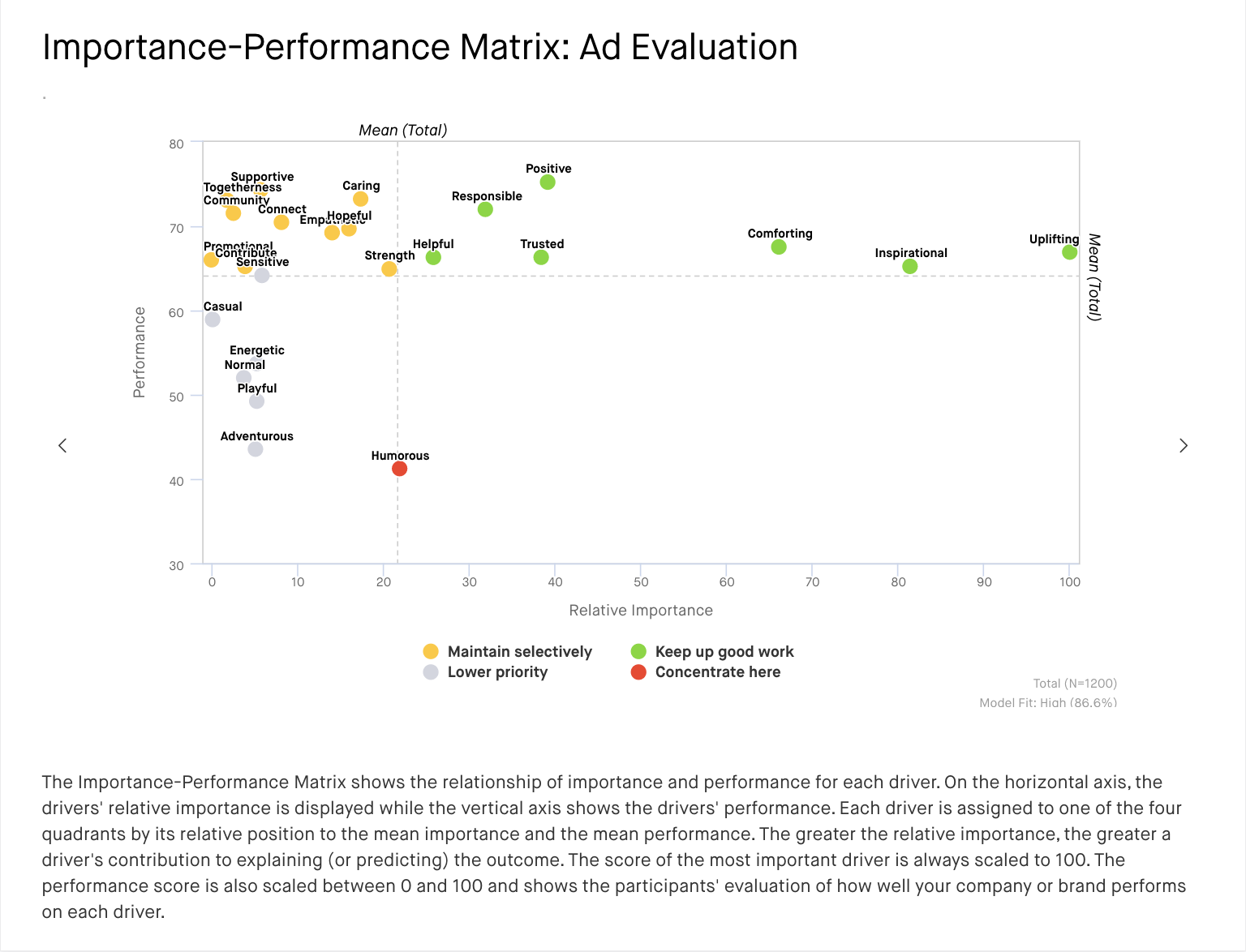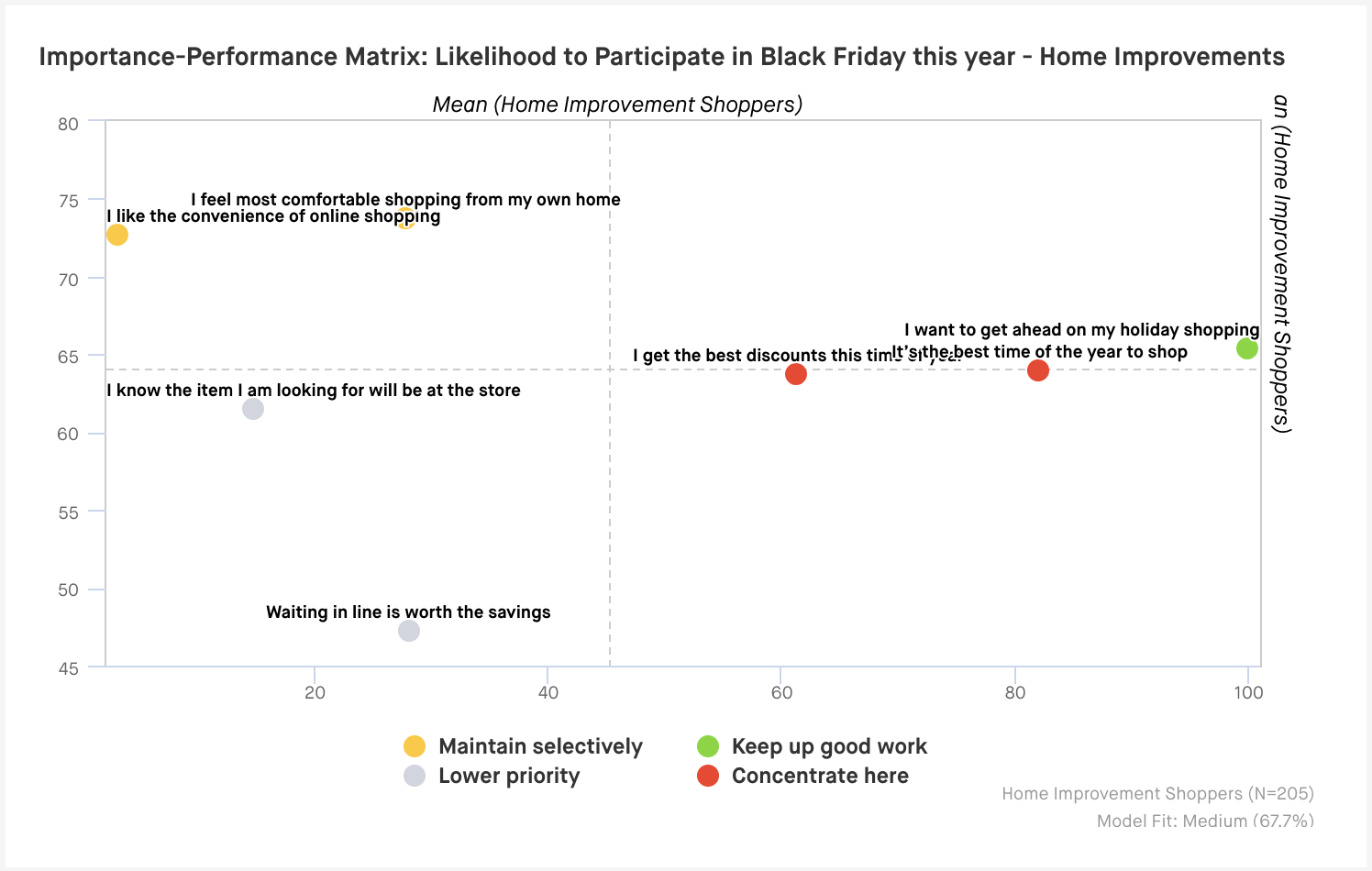How does Key Driver analysis work?
A Key Driver Analysis works by measuring the relative importance independent variables have in contributing to dependent variables/outcomes (behavior such as customer satisfaction, customer loyalty, or purchase intent). This can be done at both a category and brand level to understand the importance of potential Drivers in relation to the competitive set and your brand specifically.
In a KDA, direct and indirect drivers will likely exist. For example, 'convenience' (a direct driver of behavior) could be made up of a number of indirect drivers such as distribution, prior knowledge of the brand, or ease of ordering online. Additionally, the perception of convenience may differ by customer type so a customer segmentation can be helpful to understand different customer mindsets.
Not only can KDA be done to analyze the existing landscape of a brand or category, but it can also predict outcome variables if a certain action is taken. For example, satisfaction scores might increase or decrease depending on how the pricing or packaging of a product is tweaked. This helps form decisions around which elements of an offer should be leveraged for optimal positioning.
Back to Table of Contents
Applications of Key Driver analysis
To better understand how researchers might use a Key Driver Analysis, let's take a look at some specific applications below:
Customer Satisfaction
A brand can use a Key Driver Analysis to identify the factors that have the most significant impact on its customer satisfaction. By collecting data through online surveys or feedback forms, they can analyze responses and determine which specific aspects of their product or service drive customer satisfaction. This analysis helps a brand understand where it should focus its efforts to improve customer satisfaction and prioritize resource allocation accordingly (i.e. online chat support, return policies, call waiting time, etc.).
Similarly, a brand might use a Key Driver Analysis to understand which elements of a brand are most likely to drive customers to tell their friends and family about it through word of mouth - something known as Net Promoter Score (NPS).
Customer loyalty and retention
A Key Driver Analysis can point brands toward the factors that most contribute to customer loyalty and retention. By examining data related to customer behavior, purchase patterns, and satisfaction levels, a brand can identify what exactly it is that encourages customers to remain loyal to them. This analysis allows the brand to develop strategies to strengthen those drivers, such as improving customer service, enhancing product quality, or implementing new loyalty programs.
Audience expansion
Key Driver Analysis can be used to identify what's attracting new customers or target audiences. By studying market research study findings, demographic information, and customer feedback, a brand can determine the key drivers that influence potential customers' decision-making process. This analysis helps the brand tailor their marketing efforts to emphasize those drivers in its communications, effectively expanding its audience base.
Positioning
When a brand wants to know how it can (or already does) differentiate itself from competitors, it'll want to use a Key Driver Analysis to identify those unique selling points. Brands can use the method to identify the drivers that are most important to their target audience when choosing between competitors. This analysis enables the brand to refine its positioning strategy, highlight its strengths, and communicate its differentiating factors effectively.
New product/concept/advertising testing
When testing new products, concepts, or advertising campaigns, a Key Driver Analysis can provide insights into the factors that drive consumers' acceptance or rejection, and what influences consumers' purchase intentions. This type of analysis helps the brand fine-tune its offerings to align with the drivers that are most important to its target market. Check out this example below from an ad evaluation study, which highlights key drivers that contribute to the performance of an ad, such as being 'positive', 'helpful', 'uplifting', and 'inspirational'. It also shows areas to concentrate more on, such as 'humor'.
Purchase intent
Similar to the above, brands can identify the drivers that significantly influence consumers' likelihood to make a purchase. This analysis enables the brand to focus its marketing efforts on the drivers that are most likely to increase purchase intent - such as price, product features, brand reputation, or convenience.Benefits of Key Driver Analysis
So why would an insights team choose to run a Key Driver analysis (at all, or over another advanced method)?
This type of advanced methodology has specific advantages that allow them to make clearer business recommendations, some of which are listed below:
Knowing what drives customers
Key Driver analysis will help brands understand their performance better by exploring how different elements of the business contribute to its success. With this knowledge, brands are able to leverage different parts of their product or service offers to maximize customer appeal, popularity, and profitability.
For example, consider that a phone brand runs a KDA study and finds that one main driver of customer loyalty is brand reputation. However, reputation can encompass a number of factors, including advertising, how efficiently its customer service resolves problems, or how friends talk about the brand to someone else. The KDA might also uncover that pricing is important to customer satisfaction, particularly amongst younger customers - but its relative importance might not be quite so high when compared with the potential for frequent upgrades or availability of 5G. All of these details help the phone brand focus its efforts on what's actually driving brand reputation and customer satisfaction, rather than relying on a guess-and-check approach.
Intuitive output
With a few clicks of a Key Driver Analysis, brands can highlight the greatest levers or areas that will lead to a desired outcome such as customer satisfaction or intention to buy.
The method's Importance-Performance Matrix clearly visualizes the importance of individual drivers in connection with the performance of this driver – in other words, how highly the respondents rate the performance of the brand or company in respect to this driver (as shown below):

Reliable quality
Running an automated KDA (as done with quantilope) is simple and easy to understand. With the help of artificial intelligence and machine learning, you get reliable, top-quality results to help make strategic business decisions you feel confident about.
Back to Table of Contents
How to run a Key Driver Analysis
When it comes to running a Key Driver analysis, there are a few main steps to follow:
-
Define the objective and key performance indicator(s) (KPIs): Clearly define the objective of the analysis. Determine what specific aspect you want to understand or improve, such as customer satisfaction, purchase intent, or brand loyalty. Identify the primary metrics or KPIs that represent that objective such as customer satisfaction scores, purchase intent rating scores, or any other relevant measurement.
-
Collect data: Gather the necessary data related to the objective and KPIs through online surveys, interviews, focus groups, or any other appropriate data collection method. It's a good idea to ensure your data is representative of your target audience or customer base.
-
Identify potential drivers: Analyze the collected data to identify potential drivers or factors that may influence your chosen KPIs. Look for patterns, correlations, or relationships between a KPI and different variables, such as product features, pricing, customer service, brand reputation, or any other relevant factors.
-
Prioritize drivers: Once you have identified potential drivers, prioritize them based on their impact and importance. Statistical techniques like regression analysis, correlation analysis, or factor analysis can help quantify the relationships between the drivers and KPIs. Determine which drivers have the strongest influence on each KPI and then rank them accordingly.
-
Interpret results: Interpret the results of the analysis to gain meaningful insights. Understand the relationships between the drivers and the KPIs and explore the implications for your business or brand. Identify areas of improvement or opportunities based on what you've identified.
-
Develop actionable strategies: Based on the insights gained from the analysis, develop actionable strategies or initiatives to enhance the drivers that positively impact the KPIs. Allocate resources, create plans, and implement changes or improvements to address the key drivers effectively.
-
Monitor and iterate: Continuously monitor your chosen KPIs and track the impact of the strategies you've implemented to see if they're working. Refine and iterate your approach based on ongoing feedback, data analysis, and market dynamics. Remember to regularly reassess the key drivers to adapt to changing customer preferences or market conditions.
If the above steps sound like a lot of manual work, you'll be happy to know quantilope's automated Key Driver Analysis makes the method setup as simple as a drag&drop from an automated method library and includes automated charting as well.
All you need to do is select the drivers that you're interested in measuring and the behavior (or outcome) you'd like to explore. quantilope's KDA tool will rank the importance of drivers in terms of how they contribute to the behavior of interest, and its importance-performance matrix indicates how highly respondents rate the performance of the brand or company on each particular driver.
To see quantilope's KDA in action, check out what drives retail holiday shopping or simply get in touch below to chat with a member of our team!

^ The KDA output above shows an example of what's driving consumers' likelihood to participate in Black Friday as Home Improvement shoppers.



